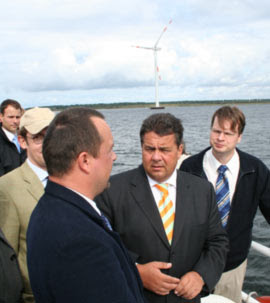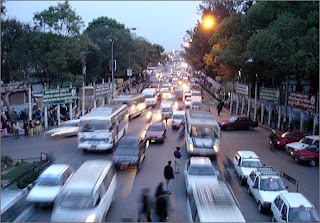 China's emergence as an economic power determined to raise the standard of living of its populace is placing immense pressure on the world's resources -- especially with respect to food and energy. That fact combined with the surge in interest by America and other countries to find biofuel substitutes for oil (in search of energy independence) is having profound impacts on agriculture and global food security.
China's emergence as an economic power determined to raise the standard of living of its populace is placing immense pressure on the world's resources -- especially with respect to food and energy. That fact combined with the surge in interest by America and other countries to find biofuel substitutes for oil (in search of energy independence) is having profound impacts on agriculture and global food security.
"How Biofuels Could Starve the Poor" by C. Ford Runge and Benjamin Senauer appears in the May/June 2007 issue of Foreign Affairs. They report on the "Ethanol Bubble" noting that
"The enormous volume of corn required by the ethanol industry is sending shock waves through the food system...Filling the 25-gallon tank of an SUV with pure ethanol requires over 450 pounds of corn -- which contains enough calories to feed one person for a year."
American farmers are planning to plant "wall-to-wall corn" for the purposes of producing ethanol. That's what government subsidies dictate they do in order to rescue their failing farm businesses from bankruptcy. How long will it take for world leaders to realize that if the lure of windfall profits tempt more and more farmers to grow crops for fuel than for food, it won't be long before we create a world of very rich and extremely poor starving people? (GW)
To Fortify China, Soybean Harvest Grows in Brazil
RONDONÓPOLIS, Brazil — For more than 2,000 years, the Chinese have turned soybeans into tofu, a staple of the country’s diet.
But as its economy grows, so does China’s appetite for pork, poultry and beef, which require higher volumes of soybeans as animal feed. Plagued by scarce water supplies, China is turning to a new trading partner 15,000 miles away — Brazil — to supply more protein-packed beans essential to a richer diet.
China’s global scramble for natural resources is leading to a transformation of agricultural trading around the world. In China, vanishing cropland and diminishing water supplies are hampering the country’s ability to feed itself, and the increasing use of farmland in the United States to produce biofuels is pushing China to seek more of its staples from South America, where land is still cheap and plentiful.
“China is out there beating the bushes,” said Robert L. Thompson, a professor at the University of Illinois who is a former director of agricultural and rural development at the World Bank. The goal, he said, is “to ensure they have access to long-term contracts for minerals and energy and food.”
Once, the biggest bilateral food trade flowed between the United States, the world’s largest food exporter, and Japan. But countries with vast arable land available for expansion, particularly Brazil, are now racing to meet demand in China, whose population of 1.3 billion is 10 times that of Japan’s.
Farmers in the United States have started planting far more corn for ethanol at the expense of other crops, including soybeans. But after the United States grain embargo by President Richard M. Nixon in the early 1970s helped spawn Brazil’s soybean industry, American farmers are not giving up their leading role in the grain trade easily.
With a far superior system for transporting crops to global markets, American farmers still enjoy many advantages over their new competitors from Brazil and elsewhere in the developing world. Infrastructure and financing constraints in Brazil will keep the competition to feed China in flux for years to come.
But the longer-term trends are apparent. At the heart of the shift is the global competition for land to grow crops. Brazil, which farms about 175 million acres, has room to double its available cropland to equal the scale of the United States, analysts say, even without clearing any more of the Amazon rainforest.
“All of a sudden you have a global market for land, a competition between several different products for the same amount of land,” said Sergio Barroso, president for the Brazil operations of Cargill, the biggest grain trader in the world. Brazil’s soybean industry is losing acres to sugar cane for ethanol production in some areas, he said, and is competing with corn, cotton and cattle.
“If you put it all together between feed and food,” Mr. Barroso said, “it is going to be a tremendous challenge.”
Expectations ran high three years ago when Hu Jintao, the president of China, visited South America and toasted a strategic partnership with his Brazilian counterpart, Luiz Inácio Lula da Silva, predicting trade between the countries would double to $20 billion. China pledged $10 billion in investments.
To some extent, Brazilians have been disappointed in the follow-up. The Chinese have struggled with red tape in Brazil and hesitated while waiting for Brazilian rules to activate public-private investments. “Very little has happened,” said Pedro de Camargo Neto, a former official in the agriculture ministry in Brazil who is now an agribusiness consultant.
But China has continued its buying spree in Brazil. The soybean trade between the countries has exploded. Last year Brazil sent nearly 11 million tons of beans to China, a 50 percent increase from the previous year and nearly double the amount shipped in 2004. Early indications are that Brazil has produced yet another record crop, and analysts expect that China will devour most of it.
While the United States remains the largest producer of soybeans, last year Brazil became the biggest exporter. This year the United States will regain the crown, but its soybean exports are expected to fall by 23 percent by 2009-10, according to the Agriculture Department.
For all the gains here, though, the surge in exports to China has created unease among many in Brazilian agriculture, who worry the tightening relationship will accelerate a development model in which Brazil is too reliant on sales of raw natural resources rather than higher-value products. And after enjoying a trade surplus with China, Brazil slipped into a deficit in the most recent quarter as the Chinese stepped up shipments of manufactured goods.
The challenge of supplying China is already showing signs of strain. A soybean boom has turned to a bust in the last two years for many farmers here in Mato Grosso, a state in western Brazil the size of Texas and Kansas that produces more than a third of the country’s beans.
Near Rondonópolis, Rogerio Salles watched recently as a handful of combines harvested the last soybeans on his 17,500-acre farm ringed by eucalyptus and rubber trees. “Just because we’re producing a lot of beans here doesn’t mean we’re making money,” he said.
The strong Brazilian currency and a transportation bottleneck are conspiring against many Mato Grosso farmers. Most of the beans are trucked south more than a thousand miles along highways riddled with potholes. At the ports, some ships wait at anchor up to a month before finding a dock to load the beans.
“If major investments are not made in transport infrastructure, China cannot count on this region being a stable supplier to its market,” Mr. Salles said. “There’s a lot riding on this.”
Moving soybeans from Mato Grosso to ports in Brazil costs more than four times what American farmers spend to get beans from the Midwest to New Orleans and the Pacific Northwest. As a result, Brazilian farms realize far less for their crops than their American counterparts.
Brazil’s agricultural sector has been dominated by large investors who bought huge tracts at cheap prices, and by multinational grain traders — like Minneapolis-based Cargill and Archer Daniels Midland, based in Decatur, Ill. — that have built storage, provided financing and lined up the overseas buyers.
Through his Maggi Group, Blairo Maggi, the governor of Mato Grosso, is the largest soybean grower in the world, and a major financier, with 400,000 acres of his own under production.
”It has been all about a land grab in Brazil,” said Daniel W. Basse, president of AgResource, an agricultural research consultancy.
For the farmers in Mato Grosso, prosperity has been elusive lately. Growers in the state amassed $14.5 billion in debt in the last two years. Farmers say they can no longer afford storage space, forcing them to sell their crops as soon as harvested, rather than wait for higher prices.
“You do all the work, you plant the right crops,” Mr. Salles, the local farmer, said. “But even when you do everything right, you still lose.”
The growers’ desperation has allowed the major grain traders to tighten their grip. Brazilian farmers say they are paying up to 25 percent more for supplies like fertilizers provided by the traders, who are paid back with the crop. “We are becoming slaves of the big trading companies,” said Ricardo Tomczyk, another farmer in Rondonópolis.
José Luiz Glaser, the general manager for grains and oilseeds at Cargill Brazil, said that Cargill stopped financing several farmers in Mato Grosso last year after they failed to pay their bills.
Such orphaned farmers could soon find new Chinese benefactors, who are looking to make inroads in the clubby world of Brazilian agriculture, said Charles Tang, president of the Brazil-China Chamber of Commerce. Brazilian farmers say they would welcome Chinese money. But they worry about China’s growing clout as a soybean buyer. Memories are still fresh of the 2004 “red beans” incident, when China rejected shipments of Brazilian soybeans after claiming they were contaminated.
To try to counter Chinese influence, Brazilian producers are working with American growers to diversify their buyers. American soybean producers organized a joint trade mission with Mato Grosso farmers in December to India, another huge potential growth market.
The Chinese want to connect directly with Brazilian farmers, bypassing the multinational grain merchants. While they have yet to make a major purchase of cropland in Brazil, they are looking to invest in improved facilities and upgrade the antiquated rail system.
China began looking overseas for more soybean supplies in the mid-1990s, when the scope of its land and water problems became clearer. Beijing has also chosen to use more of its arable farmland to grow fruits and vegetables, crops that make better use of China’s cheap labor and scarcer water supplies to generate higher returns on the export market.
In northern China, where soybeans traditionally have been grown, water tables are dropping at a rate of 3 to 10 feet a year, according to Wu Aimin, a researcher with the China Groundwater Information Center in Beijing.
“It takes a thousand tons of water to produce one ton of grain,” said Lester R. Brown, president of the Earth Policy Institute, an environmental research and advocacy group. “So the most efficient way to import water is in the form of grain.”
 Pursuant to their commitment to reduce greenhouse-gas emissions, countries like Germany and Spain have instituted a number of innovative policies designed to and spur the deployment of renewable energy technologies by making them more cost competitive with fossil fuels.
Pursuant to their commitment to reduce greenhouse-gas emissions, countries like Germany and Spain have instituted a number of innovative policies designed to and spur the deployment of renewable energy technologies by making them more cost competitive with fossil fuels.














